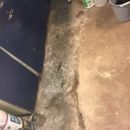Reducing humidity from basement floor
Back in the mid-50s in this 1924 house when sewer lines were put in they buried the stack in the basement floor, ran it to a cleanout and then to the house trap/cleanout.
The attached photo shows the dug-up and then sloppily re-cemented floor area where the waste line from the slop sink ran to meet the stack. (mostly under the work bench, maybe 30 sq ft, then another twenty from the first cleanout to the house trap.) That twenty is now hidden under the stairway closet.
For years we’ve had to have a de-humidifier on 24-7 in summer which costs alot in electric charges. I always thought, because of some wall effluorescence that that north wall was the source. But I recently noticed how that floor cement never quite gets dry in summer, and wondered if I should find some way t seal this with paint, etc. If I have to re-cement with better, more waterproof material, it might be wise to re-do the underground slop sink waste line in case it’s leaking. Any quick fixes for this?
Note I don’t see this problem in any other basement wall or floor area–though theoretically it could be hidden behind the sheetrock of the rest of the basement which is finished. But i looked and don’t see the problem.
GBA Detail Library
A collection of one thousand construction details organized by climate and house part










Replies
The source of the moisture on the concrete in summer is most likely to be coming from the ventilation air, not the ground. Air sealing the basement from outdoor ventilation air will do more for this problem than any sealer. (It doesn't hurt to apply a sealer though.)
A skim coat of Xypex® or a silane/siloxane based concrete sealer would reduce capillary draw from any ground moisture, but won't do anything for adsorbed moisture from the air.
Thanks there are gaps in the rim joist in this mechanical room; could fill with home depot foam but I heard that termites like to nest in stuff. I guess I had always assumed water was seeping in through the walls, hence the efflorescence before I had the wall re-pointed some years back.
There may indeed be moisture seeping through the walls, but that's a year-round phenomenon. If the concrete only looks actively wet and the dehumidifier duty cycle is only high in summer, it's almost certainly the high humidity of summertime air.
If you don't want to seal the gaps in the band joists or between the sill and foundation with can-foam, use polyurethane caulk (up to about a half-inch). ALL air leaks into the basement matter, not just the ones in the mechanical room. The single largest air leak in most previously untreated homes is the band joist & foundation sill leakage, which is usually several times that of all the window & door crackage in the house.